
Southington is a town in Hartford County, Connecticut, United States. As of the 2010 United States Census, it had a population of 43,069. Southington contains the villages of Marion, Milldale, and Plantsville.

Plantsville is a neighborhood in the town of Southington, Hartford County, Connecticut. It is centered at the merger between South Main Street and West Main Street. As of the 2000 Census there were 10,387 people living in the Zip Code Tabulation Area for zip code 06479, which is assigned the postal city name Plantsville. The Zip Code Tabulation Area includes the entire southwestern corner of the town of Southington, including Marion and Milldale. Beginning in 2015 Plantsville was listed as a census-designated place.
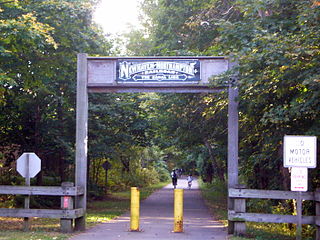
The Farmington Canal, also known as the New Haven and Northampton Canal, was a major private canal built in the early 19th century to provide water transportation from New Haven into the interior of Connecticut, Massachusetts and beyond. Its Massachusetts segment was known as the Hampshire and Hampden Canal. With the advent of railroads, it was quickly converted to a railroad in the mid-19th century and in recent years has been converted to a multi-use trail after being abandoned for years.

Italian Village is a neighborhood in Columbus, Ohio, that contains an array of residential, commercial, and industrial buildings. It is a designated historic district, known for its historical and cultural preservation. The building types and architecture reflect Italian influence. With its parks and preserved historic homes, Italian Village has the highest home value appreciation in Columbus.

The Russell Company Upper Mill is an historic structure in Middletown, Connecticut, built in 1836 and listed on the National Register of Historic Places. The building stands at the junction of Russell Street and East Main Street in South Farms. There is a small pond to the south. East Main Street's commercial and industrial development ends there. To the north, small businesses border the street, followed by the buildings of Russell Manufacturing Company, the area's most dominant feature. Russell Street crosses Sumner Brook nearby and ascends to a large residential district to the west. The mill is currently a condo-apartment complex.

Turners Falls Historic District is a historic district encompassing much of the historic center of the village of Turners Falls in the town of Montague, Massachusetts. The village is a well-preserved example of an 1870s planned industrial community. It is roughly bounded by the Connecticut River, Power Canal, 9th and L Street. The district was listed on the National Register of Historic Places in 1982.
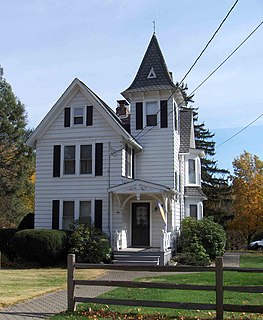
Marion is a neighborhood in the town of Southington in Hartford County, Connecticut, United States. It is generally the area in the vicinity of the intersection of Route 322 and Marion Avenue just north of the Cheshire town line.

The Asa Barns’ Tavern, also known as the Levi B Frost House, is an historic building in the Marion village of Southington, Connecticut. The home represents over two centuries of Southington history. Appearing twice on the National Register of Historic Places, as an individual structure and as a part of the Marion Historic District, the house is significant both architecturally and historically for its connection to United States and New England history.

The River Street Historic District encompasses a historic industrial area in the Fair Haven section of New Haven, Connecticut. Located south of Church Street between James Street and Blatchley Avenue, the industrial buildings here date to New Haven's growth as a major industrial center between the American Civil War and World War I, with significant emphasis on metalworking businesses. The district was listed on the National Register of Historic Places in 1989.

The Atwater Manufacturing Company is a historic industrial property at 335 Atwater Street in Southington, Connecticut. The company, founded in 1867 and now known as Rex Forge, has long been one of Southington's major industrial employers. The ten extant buildings of the complex date as far back as 1912, and are an important element of the town's industrial past. The property was listed on the National Register of Historic Places in 1988.

The Blakeslee Forging Company is a historic industrial complex at 100 West Main Street in the Plantsville area of Southington, Connecticut. The surviving six buildings, dating to about 1910 or later, were developed for a company founded in 1877 that specialized in drop forging. The buildings are well preserved structures typifying industrial buildings found in Southington from that era. The complex was listed on the National Register of Historic Places in 1988.

The Clark Brothers Factory No. 1 was a historic industrial complex at 1331 South Main Street in the Milldale area of Southington, Connecticut. Developed beginning in the 1850s, it was one of the nation's largest sources of carriage bolts. The complex listed on the National Register of Historic Places in 1988 consisted of a group of brick buildings dating to 1893 and later. It has since been entirely demolished, and the land stands vacant and overgrown.

The Hurwood Company is a historic industrial complex at 379 Summer Street in Southington, Connecticut. Built beginning sometime before 1884, this complex of mainly brick buildings is typical of the town's industrial landscape of the late 19th and early 20th centuries, and was where solid-headed screwdrivers were first manufactured. The complex was listed on the National Register of Historic Places in 1988.
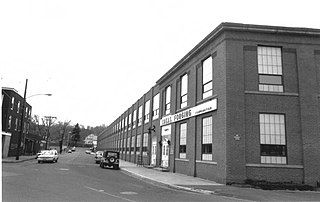
The Peck, Stow & Wilcox Factory was a historic factory complex at 217 Center Street in Southington, Connecticut. Begun in 1870, it was home to the town's largest industrial employer of the late 19th century. Surviving elements of the factory, dating to 1912, were listed on the National Register of Historic Places in 1989. The complex, last used by Ideal Forging, was demolished in 2015 after it was shuttered in 2003.
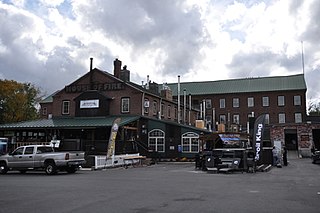
The Pultz & Walkley Company, also known more recently as The Five Star Company, is a historic industrial complex at 120 West Main Street in the Plantsville village of Southington, Connecticut. Founded in the 1870s, Pultz & Walkley was a major producer of paper bags. The multi-building complex is one of the town's better-preserved industrial properties, and was listed on the National Register of Historic Places in 1988.

The H. D. Smith Company Building is a historic industrial building at 24 West Street in Plantsville, Connecticut. With a construction history dating to 1882, it is one of the more architecturally interesting examples of Southington's industrial architecture, and was home to H. D. Smith & Co. from construction to the 1920s. It was listed on the National Register of Historic Places in 1977.

West Street School is a historic one-room school house at 1432 West Street in Southington, Connecticut. Built about 1760, it is the oldest surviving school building in the town. It served the town as a school until 1946, and is now preserved by the Southington Historical Society. It was added to the National Register of Historic Places in 1988.
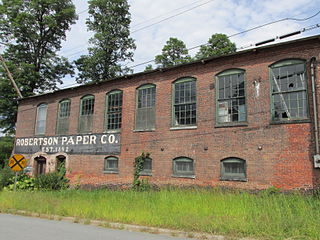
The Robertson Paper Company Complex was a historic industrial facility on Island Street in Bellows Falls, Vermont. It consisted of a collection of mostly-interconnected factory and related buildings, built between c. 1890 and c. 1960 by various paper-related companies. It was occupied and enlarged by the Robertson Paper Company between 1907 and its failure in 1987, at which time it was the longest-lived paper company in the state. The complex was listed on the National Register of Historic Places in 1990. It was demolished in 2018-19 as a Brownfields Economic Revitalization Alliance (BERA) project, with federal, state, and local funding.

The Home Woolen Company is a historic textile mill complex on Main Street in Beacon Falls, Connecticut. Developed between 1853 and 1916, the complex housed major local employers, engaged first in the manufacture of woolens and rubber products. The complex has been converted to residential use. It was listed on the National Register of Historic Places in 1984.

The Matthews and Willard Factory was a historic industrial site at Cherry Avenue and North Elm Street in Waterbury, Connecticut. Founded in 1874, Matthews and Willard contributed to the expansion of Waterbury's brass processing industry. The plant remained little altered from its last period of expansion c. 1900, and was a good example of period industrial architecture. It was listed on the National Register of Historic Places in 1988, and was demolished in 2012. As of 2018, the site stands vacant.





















